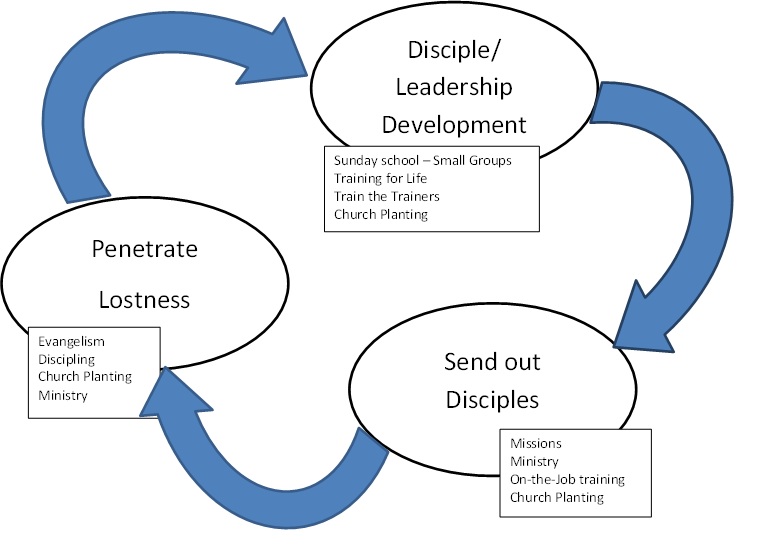Strategy Plan for the Baptist Convention of Iowa
September 22, 2012
Introduction
As the Strategy Team met to develop a strategy for the Baptist Convention of Iowa (BCI) it was guided by three underlying principles. 1). The Strategy Team’s role was to develop a strategy that will allow BCI to focus on what it will take to reach Iowa for Christ. 2). We understand that if we are to accomplish this task it will take a singular focus that includes developing strong, healthy churches made up of strong, healthy disciples who in turn produce new congregations and disciples. 3). Finally, as Baptists we understand that foundational to who we are, is a strong sense of collaboration reflecting Jesus’ prayer in John 17:22b “…that they may be one as we are one…” As such we are making plans for BCI and recommendations to our ministry partners.
This document will lay out the general scope of the strategic plan developed by the Strategy Team (Mike Carlson, Roger Graves, Tom Law, Tim Lubinus, Jim Perkins, Gene Stockton, and Dan Wiersema). This strategy revolves around three concepts: clusters, stack pole churches, and leadership development systems. 1). Clusters are organic groupings of congregations who give each other mutual support through fellowship; help each other develop leaders; and plant new churches. (These may be referred to as associations, networks, areas, etc. They may be linked by proximity (geography), affinity, and/or progeny.) 2). Stack pole (Equipping) churches are congregations who take responsibility for their surrounding community, county, or counties; who actively develop new leaders; and whose pastors understand that in addition to their pastoral duties their principle function is to mentor and equip leaders who can give pastoral leadership to small groups and congregations in the areas that surround the church (Ephesians 4:11-12). 3). Leadership Development Systems (pipelines or “farm clubs”) are a natural outgrowth of this process as disciples and potential leaders are mentored; identified and trained; given on-the-job training as small group leaders; and moved out into existing congregations and new church plants.
In the development of the strategy it became obvious that, in order to implement this plan, administrative changes would also be required. The BCI Administrative Team has prepared a separate document which includes many of these changes. As with any change process many changes will not become obvious until other changes have been implemented. As such this will be an ongoing process.
Finally, it will take a concerted effort, working together, and focusing on doing “whatever it takes” to reach Iowa. We, as a fellowship of churches in Iowa, must embrace the changes necessary to reap the harvest of the Great Commission (Matthew 28:18-20).
Plan
The following diagram will help us visualize three things: 1). this is a process that does not end; 2). a person, church, or cluster can enter the process at any point; and 3). there is a lot of overlap because this is a spiral moving us forward, not a circle moving us around. 
Key to the development and implementation of this plan is the local church. It grows to a unified effort in the cluster. The role of the BCI is to help chart the course, resource the leaders, encourage those along the way, and provide accountability that, in fact, we are moving in the way that God would have us.
Leadership Development and Discipleship
Central to the success of this strategy is the development of strong healthy stack pole (equipping) churches. We understand that foundational to this process is developing strong healthy Christ-followers and servant leaders in our congregations. Therefore, it is incumbent on us to develop ways to help churches: disciple those who have come to know Jesus as Savior and Lord; discover those disciples with leadership potential; and invest in these leaders so that they can train others. As we visualize of this concept it might be helpful to think of the high school coach verses a college coach. A college coach searches the nation for the best talent. However, high school coaches must work with what they have. High school coaches who are most successful work with the junior high coaches to identify talented young athletes and equip them to become stars when they reach high school. The very best programs collaborate with those at the elementary school level to help these teachers know how to begin developing young athletes for excellence. Similarly, we seek to encourage the churches in the development of committed disciples and leaders in the pursuit of the Great Commission. The Cluster Facilitator will work with the leadership of the cluster to facilitate this process. Special attention will be given to training and equipping pastors of stack pole (equipping) churches who will equip and mentor the leadership of the small groups and congregations in the surrounding communities.
Church Planting
At the core of the BCI strategy is to start new congregations while strengthening existing ones. Often new congregations impact lostness more effectively than older ones. One reason is that newer churches are aggressively penetrating the edges of darkness. There remains much need for the expansion of Christ’s kingdom in Iowa. Forty-eight counties in Iowa do not have any BCI presence. Another 22 counties have smaller congregations and many of these are actually on the geographic edge of the county potentially leaving much of the county unreached. From this perspective, 70 of the 99 counties in Iowa have little or no BCI presence. In addition, many in larger cities have little access to BCI churches. Another statistic would indicate that as much as 77% of the population of Iowa is not part of an evangelical community. That figure may actually be much higher. Therefore we should focus a large part of our resources (time, money, energy, personnel, etc.) on church planting.
Missions
We must keep our eyes focused on the fields that are “white unto harvest” and listen to hear the Spirit calling out those who will minister in those fields. Developing partnerships so congregations can see and participate in what is happening in other places allows us to encourage one another, and learn from one another as we listen to what the Spirit says to the churches. Keeping the focus on the needs, spiritual and physical, both within the State and outside its borders keeps us challenged with the unfinished task and keeps our congregations from becoming inwardly focused. Finally, we must understand that regardless of size and resources every church can engage its community with the love of Christ.
Developmental Goals
· Promote the organic development of church groupings referred to as “clusters” in this document.
· Develop at least one strong healthy BCI congregation in every county in Iowa and among every neighborhood of 10,000.
· Assist in developing stack pole churches whose leadership takes responsibility for reaching the surrounding communities.
· Reaffirm the goal of 200 churches by 2020 – this would mean one church for every 10,000 people in metropolitan areas (1.1 million divided by 10,000 equals 110) and a church within thirty minutes’ drive in the approximately 90 rural, semi-rural, semi-urban counties in Iowa.
· Development of a leadership pipeline or farm club which will provide leaders and pastors for the churches and new church plants. This means developing a strategy and process promoting Iowans reaching Iowa.





